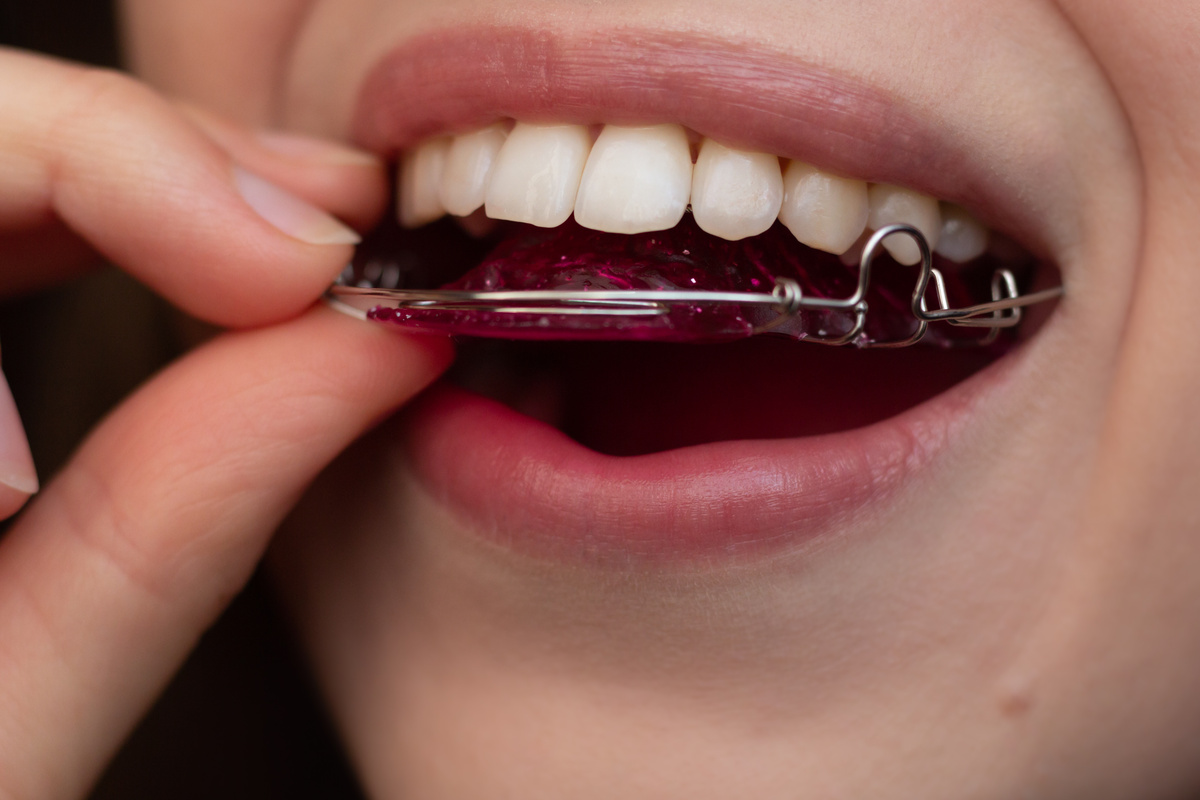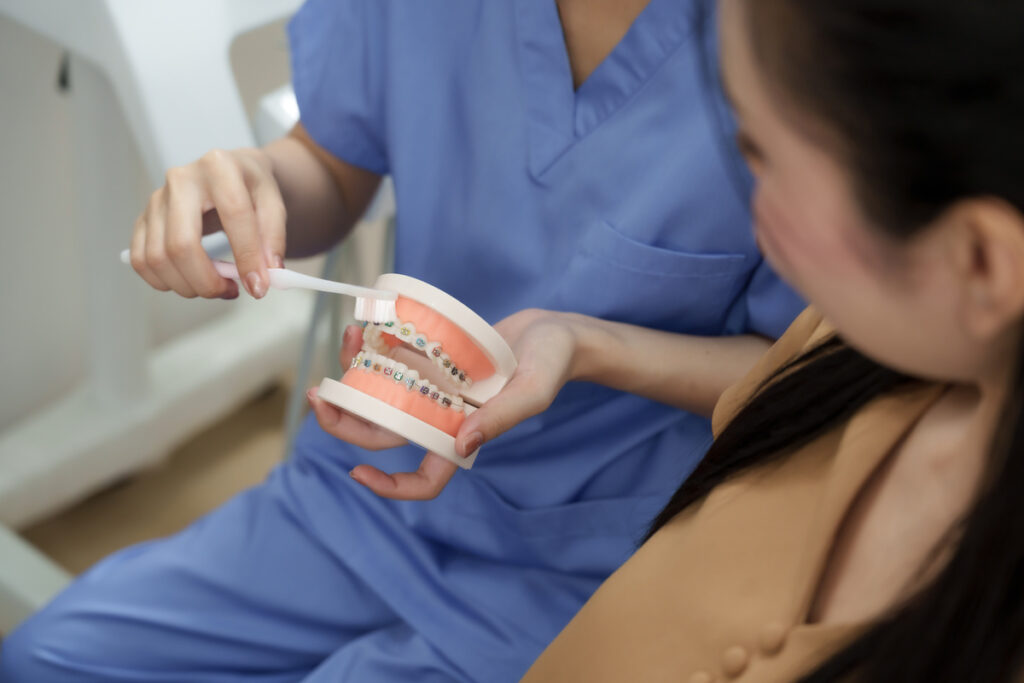Getting your braces removed is a momentous occasion that’s absolutely worth celebrating. However, it’s also important to remember that keeping your smile beautiful and straight is a lifelong commitment. Once your braces are removed, you’ll enter the retention phase of your treatment, which follows active orthodontic treatment. Braces straighten teeth, and retainers help maintain this alignment by keeping your teeth in their new positions.
At Lazzara Orthodontics, we field a lot of questions about “How long do I need to wear a retainer?” and “How long do retainers last?” Our patients usually have three retainer check visits in the first year after their braces are removed. Successful retention depends on the patient’s willingness to accept and follow instructions for wearing and caring for their retainer.
Our patients are expected to wear their retainers full-time except when eating and brushing for the first 6 weeks after treatment is completed. A retainer helps maintain the new positions of your teeth after braces, preventing them from shifting. Retainers keep your teeth in their new positions after active orthodontic treatment. Assuming a good report at the 6 week retainer check visit, most patients go to nights only for the next 11 months or so. Once this “active retention” phase is completed, most patients are instructed to wear their retainers for a few nights per week, indefinitely.
How long a retainer lasts will depend on how well you care for your retainer. A retainer is a device designed to maintain the alignment and positions of your teeth achieved during treatment. Each person’s retention needs may vary, and the goal of orthodontic treatment is to straighten teeth—retainers are essential to maintain this result. Without retainers, your teeth may shift back to their original position. Retainers also support the bone as your teeth settle into their new positions, while bones and soft tissues adapt to the new alignment after treatment.
Depending on your case, retainers may be applied to the upper teeth, anterior teeth, or even all six anterior teeth. A dentist or orthodontist is responsible for fitting and monitoring your retainers, and both dentists and orthodontists are qualified to provide this care. In this blog, we’ll explain the differences in durability between these two types of retainers and also provide some tips for getting the most life out of your retainer.
Introduction to Retainers
Retainers are a crucial, custom-made part of your orthodontic journey, designed to help your teeth stay in their new position after braces or other orthodontic treatment. These devices are typically crafted from wires or clear plastic and are tailored to fit your mouth perfectly. The essential part of wearing a retainer is to maintain the alignment achieved during treatment and prevent your teeth from shifting back due to the natural pressures from surrounding soft tissues, your bite, and even ongoing growth. There are different types of retainers to suit various needs, including fixed retainers (bonded wires attached to the back of your teeth), removable retainers (which you can take out for eating and cleaning), Hawley retainers (made of acrylic and wire), and vacuum formed retainers (clear plastic trays that fit snugly over your teeth). Each type offers unique benefits, but all share the same goal: to keep your smile straight and healthy for years to come.
How Long Do Fixed Retainers Last?
Fixed retainers (sometimes called “bonded or permanent” retainers) are tiny metal wires glued to the back of your anterior teeth—often spanning all six anterior teeth from canine to canine. These retainers can be placed on the lower or upper teeth, depending on your case, to maintain the new positions of your teeth and prevent relapse after correcting issues like crowding. Dr. Lazzara generally recommends this option if there was significant crowding in the lower teeth before braces. Because they can be more difficult to keep clean, he also typically recommends them only for patients with a demonstrated history of good oral hygiene habits.
With the right care, fixed retainers can offer an experience that is practically “set it and forget it.” Once bonded, these devices are impossible to lose, so patients don’t have to worry about losing retainers or forgetting to wear them. It’s usually a quick fix to reattach a fixed retainer if it becomes loose or comes off due to everyday wear-and-tear caused by eating, brushing, etc.
At Lazzara Orthodontics, we generally recommend keeping fixed retainers in place for at least two years. The first six months after placement are especially important for monitoring retainer performance and preventing relapse, as this period is critical for maintaining treatment results and identifying any early failures. If there are not significant oral hygiene problems or tartar build-up around the retainers after that period, then we’ll typically recommend keeping the fixed retainer in place.
With proper care, these retainers can last up to 10-20 years before they require replacement. However, they are not indestructible. Grinding can increase the risk of fixed retainer breakage or detachment, so you will need to take care of them to make sure they do not become damaged.
If a patient decides to remove their fixed retainers at any point, then they will still need to regularly wear a removable retainer.
How Long Do Removable Retainers Last?
Removable retainers generally come in two forms – an Invisalign-style clear retainer, which is a custom-made, removable, and discreet clear retainer made of clear plastic that goes over your teeth, or the traditional “Hawley” retainer, which is a type of wire retainer made of plastic and metal wire. The Hawley retainer features a key component called the labial bow, which helps with retention and aesthetics, and some Hawley retainers use a clear wire instead of a traditional metal wire for improved aesthetics. Another option is the vacuum formed retainer, a clear plastic tray made using a vacuum forming process.
Both types of removable retainers, including clear retainers and wire retainers, can typically last up to 2-3 years, depending on the wear and tear they experience. Dropping, squeezing, or bending your device can decrease its lifespan, and losing a removable retainer will obviously necessitate its replacement. When considering a replacement, retainer cost is an important factor, and a vacuum-formed retainer may cost only a fraction of the price of a Hawley retainer.
It’s essential to closely inspect the retainer for chips, cracks, fit issues, or other structural problems that may compromise its effectiveness. Grinding your teeth can also damage the device. If your retainer is not worn as directed, your teeth may shift. And remember: when it’s not in your mouth, your retainer should be in its case!
Of course, you can reduce these problems by giving proper and consistent care to your removable retainer. So what exactly does “proper care” look like?
Upper and Lower Retainers: Is There a Difference?
When it comes to keeping your teeth straight after orthodontic treatment, both upper and lower retainers play a vital role—but they aren’t always identical. Upper and lower teeth have different shapes, functions, and are exposed to different forces from your bite, tongue, and surrounding soft tissues.
For example, upper retainers may be designed to withstand more pressure from chewing, while lower retainers often need to account for the constant movement of the tongue and the risk of shifting. Orthodontists carefully select the best type of retainer for your upper and lower teeth, sometimes recommending different types for each arch to ensure the best fit and stability.
Whether you need a fixed retainer, a removable retainer, or another style, your orthodontist will tailor the approach to your unique needs, helping you maintain the results of your treatment and keep your smile in top shape.
Common Retainer Problems
While retainers are essential for maintaining your new smile, they can sometimes present challenges. One of the most common issues is breakage, which can happen if you grind your teeth at night or accidentally bite down too hard. Plaque accumulation is another concern, as it can lead to tooth decay and gingival inflammation if retainers aren’t cleaned properly. To avoid these problems, it’s important to gently scrub your retainer with a soft brush and keep up with your oral hygiene routine.
Younger patients may occasionally experience discomfort or irritation from their retainers, but your orthodontist can help by adjusting the fit or recommending an alternative type of retainer if necessary. Staying proactive about care and communication with your orthodontist can help you avoid most retainer-related issues and keep your teeth and gums healthy.
Retainer Replacement: When and Why?
Even with the best care, there may come a time when your retainer needs to be replaced. Over time, normal wear and tear, accidental breakage, or changes in your teeth or bite can cause a retainer to lose its fit or effectiveness. If your retainer no longer fits properly, feels uncomfortable, or has visible damage, it’s important to consult your orthodontist about getting a replacement to ensure continued orthodontic retention. The cost of a new, custom-made retainer can vary, typically ranging from $100 to $500 depending on the type and your orthodontist’s fees. Investing in a replacement when needed is essential for maintaining your results and protecting your smile for the long term.
How To Make Your Retainers Last Longer
Just as permanent and removable retainers have different expected lifespans, each type of retainer device also requires a specific care routine in order to last as long as possible. For permanent retainers, we recommend that our patients:
- Avoid the same problematic foods that you avoided while wearing braces, such as hard candies and very sticky food that can potentially damage your permanent retainer.
- Brush more often. If you are able to brush after every meal, you can help eliminate microbes and bacteria that will be attracted to your permanent retainer.
- Adjust your flossing routines. It will take more time to floss around the wire attached to the back of your teeth, so you may want to consider purchasing a floss threader. This specialized tool can help you work floss in between your teeth and under the wire.
- Get regular teeth cleanings, so that you can catch any problems like excess tartar build-up early.
- Be aware that grinding your teeth can increase the risk of damaging your permanent retainer.
- If your fixed retainer becomes loose, breaks, or detaches completely, then contact Dr. Lazzara as soon as possible.
When caring for a removable retainer, one advantage is that they provide less of an impediment to your normal brushing and flossing routines. However, we still recommend following these best practices to get the most life out of your removable retainers:
- Use your case whenever your retainer is not in your mouth. It can be tempting to wrap your retainer in a napkin while dining out, for instance, but this is a surefire way to lose it, as removable devices are easily lost if not stored properly.
- Avoid squeezing your retainer or playing with it excessively, such as sliding it on and off your teeth repetitively, in order to maintain its shape.
- Keep your retainer out of reach from pets. Otherwise, they might mistake it for their next chew toy.
- Clean your removable retainer device each day. Use an old toothbrush and dish soap when possible. It’s alright to occasionally brush the retainer with toothpaste, but excess exposure may scratch your retainer.
Importance of Regular Check-Ups
Regular check-ups with your orthodontist are key to making sure your retainers continue to do their job. During these visits, your orthodontist will review the fit of your retainer, look for any signs of wear, tooth decay, or gingival inflammation, and make any necessary adjustments.
These appointments are also a great opportunity to catch any shifting teeth early and address issues before they become bigger problems. By wearing your retainer as directed and attending systematic reviews—often every six months—you can help maintain your straight teeth and enjoy a healthy, confident smile for life. Regular professional oversight ensures your orthodontic retention stays on track and your investment in your smile lasts for years to come.
We’re Here To Help With Your Retainer Questions
Ultimately, how long can a retainer last is just one factor in determining the right option for your specific needs. Finding the best fit for you is extremely important, because relapse is a serious concern for almost anyone who has worn braces to correct misalignment issues. We never want to see any of our patients lose the product of all their hard work and investment. If you have any questions about retainers, contact us at (904) 270-8750 or contact us online.









